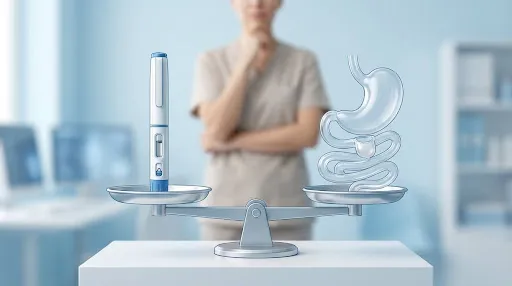Lamotrigine is widely used for epilepsy and bipolar disorder. It's known to reduce seizures and manage mood swings in many patients. But like most medications, how you take it matters just as much as why you take it. One thing that often gets overlooked? Your diet.
If you’ve ever wondered what foods to avoid when taking lamotrigine, you’re not alone. Certain meals can impact how this drug works in your body. They can lower absorption, increase side effects, or interfere with how the liver breaks it down. That can make treatment less effective, and symptoms harder to control.
This guide explains what you need to skip, what’s safe, and how to make lamotrigine work better with your lifestyle.
What Happens When Food Interacts with Lamotrigine?
Your body breaks down lamotrigine (brand name “Lamictal”) using liver enzymes. Some foods slow down these enzymes, others speed them up, while some create a reaction when mixed with the drug’s active compounds. When lamotrigine is not metabolized and absorbed properly due to the interruption of certain foods, its levels in the blood can go too high or too low. Both scenarios can cause problems. Too little may lead to breakthrough seizures or mood dips, while too much may make you feel sleepy, dizzy, or nauseated. So, a proper diet is important to increase the effectiveness of the lamotrigine.
10 Foods To Avoid With Lamotrigine
Your body breaks down lamotrigine using liver enzymes. Some foods slow these enzymes down. Others speed them up. Some create a reaction when mixed with the drug’s active compounds. The result? Less control over seizures, mood instability, and unpleasant symptoms.
For those managing bipolar disorder or epilepsy, diet isn't just about calories or weight—it’s about mental balance, stability, and safety. Nutrition, along with lamotrigine, becomes part of your care plan.
Let’s begin with the foods you should avoid—or eat only in limited amounts—if you're on lamotrigine.
1. Refined Grains
-
Example includes white bread, white pasta, baked goods, white rice, and chips.
-
Excessive intake of refined grains can lead to a quick rise in blood sugar levels, as these foods high glycemic index.
-
This affects energy levels and mood stability that are associated with bipolar disorder, thus impacting the mood-stabilizing benefits of the lamotrigine.
What to eat instead: A low-carb diet rich in foods, like lean meats, eggs, nuts, leafy green vegetables, apples, blueberries, seeds, and unsweetened dairy products.
2. Sugar-Rich Foods
-
Avoid sugar, candy, honey, cookies, pastries, desserts, syrup, sugary drinks, ice cream, and energy drinks in excess amounts.
-
High consumption of sugary foods and drinks can increase blood sugar levels, which can trigger seizures (the symptom of epilepsy).
-
Excess sugar intake can also cause inflammation, which can affect the effectiveness of the medicine and overall brain health.
What to eat instead: Low-glycemic fruits, such as pears, apples, and berries, and lean proteins to maintain blood sugar levels.
3. Grapefruit & Grapefruit Juice
-
The U.S. Food and Drug Administration (FDA) states that grapefruit can impact the activity of enzymes, which are responsible for metabolizing (breaking down) drugs.
-
This can result in increased levels of the drug in the bloodstream. As a result, it can increase the risk of side effects and harmful conditions.
-
So, avoid consuming grapefruit raw or in juice form, especially in excess amounts.
What to eat instead: Have non-citrus fruits such as pears, bananas, berries, and apples, or choose citrus fruits like oranges or mandarins, as they have no enzyme-blocking effect.
4. Sodium-Rich Foods
-
Examples are canned foods (like canned meat, fish, or soups), frozen breaded meats, fast foods, salted nuts, savory snacks, and beans sealed with added salt.
-
High intake of these foods can increase blood pressure levels, which, in turn, can worsen neurological-related symptoms, like headaches or dizziness.
-
Moreover, excessive sodium can cause dehydration and fluid retention, which may impact the effectiveness of the medicine.
What to eat instead: Consume whole foods such as fruits, whole grains, vegetables, and unsalted nuts.
5. High-Fat Foods
-
Examples include high-fat meats (e.g., sausages, pork, or fatty cuts of beef), full-fat dairy products (e.g., cheese, whole milk, butter, and cream), fried foods (e.g., French fries, fried fish, and fried chicken), and processed foods (like processed snacks).
-
A high-fat diet can slow down the absorption of lamotrigine, which can affect the entry of the medicine into the bloodstream.
-
In addition, it may also cause inflammation and impact brain health, which can reduce the seizure-controlling and mood-stabilising properties of lamotrigine.
What to eat instead: Take healthy fat-rich foods such as avocados, seeds, nuts, and olive oil and add lean proteins (like chicken and legumes) and complex carbs (such as brown rice, whole grains, and quinoa) for better drug absorption and steady energy levels.
6. Star Fruit
-
Avoid it with lamotrigine, as it may increase the chances of seizures, especially in people with kidney issues.
-
This fruit consists of a neurotoxin known as caramboxin, which might harm the brain when the kidney function is impaired.
-
Moreover, it can reduce the effectiveness of Lamotrigine and exacerbate seizure activity.
What to eat instead: Eat nutrient-rich fruits such as oranges, apples, berries, or pears.
7. Caffeine-Rich Foods
-
Examples are coffee, tea, chocolate, and energy drinks.
-
Research shows that caffeine can trigger the symptoms of mania (high emotions) in people living with bipolar disorder and impact the metabolism of certain medications like lamotrigine to treat this condition.
-
Also, high intake of caffeine can disrupt the sleep cycle, which can trigger mood or seizure episodes in people living with epilepsy or mood disorders.
What to consume instead: Choose caffeine-free herbal teas such as peppermint or chamomile tea, or low-caffeine drinks, e.g, green tea (in moderate amounts).
8. Tyramine-Rich Foods
-
Examples include aged cheeses (e.g., cheddar, stilton, or roquefort), fermented foods (e.g., tofu, sauerkraut, yeast extract, and kimchi), and cured and processed meats (e.g., salami, hot dogs, and bacon).
-
Tyramine-rich foods can affect the levels of lamotrigine in the bloodstream, which can increase the risk of seizures.
-
Also, these foods contain vasoactive compounds, which can trigger neurological symptoms like headaches or migraines in people with epilepsy or mood disorders.
What to eat instead: Consume fresh and non-fermented foods like lean meats, tofu, and eggs, unaged cheese (e.g., cream or mozzarella cheese), or low-fat dairy products.
9. Alcohol
-
Examples of alcoholic beverages include wine and beer.
-
Alcoholic beverages can increase the risk of lamotrigine's side effects, such as drowsiness, dizziness, or poor coordination.
-
A study shows that alcohol can impact the mood swings associated with bipolar disorder.
-
Also, it can enhance the lamotrigine's sedative effects, causing more drowsiness and impacting the ability to concentrate or do tasks that need alertness by acting as a depressant on the body’s central nervous system. This can increase accident risks.
What to eat instead: Consume non-alcoholic options such as herbal teas, sparkling water infused with lemon, or mocktails made of fresh herbs & fruits. Drink hydrating beverages like coconut water, plain water, coconut water, etc.
10. Dietary or Herbal Supplements
-
Examples include St. John’s Wort, Ginkgo biloba, Ginseng, Garcinia Cambogia, and Vitamin B6.
-
Some dietary or herbal supplements can interrupt the metabolism of lamotrigine, reducing its effectiveness or increasing the risk of side effects.
-
Some herbal supplements might worsen neurological-related or mood symptoms.
-
As herbal products aren't tightly regulated by the FDA and may contain some hidden ingredients that can interact with lamotrigine, avoid them or inform your doctor before taking any supplements.
What to consume instead: Focus on eating a well-balanced diet rich in lean proteins, fruits, whole grains, veggies, and healthy fats that naturally deliver vital nutrients. If supplements are necessary, seek a doctor’s advice first.
General Tips When Taking Lamotrigine
Here are the dietary tips you should follow to avoid the risk of interaction and side effects of lamotrigine:
-
Discuss your diet, current medicines, and any dietary or herbal supplements with a doctor to avoid the risk of interaction.
-
Stay hydrated for proper functioning of the body and hydration that can avoid the risk of side effects, such as dizziness and headaches.
-
Consume a balanced diet to strengthen overall neurological health.
-
Avoid sudden changes in dietary regimen, especially if you are managing your bipolar disorder, as it can interrupt the metabolism and absorption of the medicine.
-
Keep a check on food triggers to help identify the major culprit.
-
Do not skip meals, as this can help maintain steady levels of blood sugar, preventing side effects, such as lightheadedness or dizziness that some individuals experience with lamotrigine.
What Are The Foods To Eat With Lamotrigine?
If you have concerns about the lamotrigine interactions with certain foods, there are other food options you can opt for that may include:
-
Non-citrus fruits: Apples, blueberries, bananas, watermelon, pears, blackberries, raspberries, and kiwi. Provide vitamins and antioxidants without the risk of interfering with the metabolism of lemotrigine.
-
Low-protein foods: Oats, avocado, leafy green veggies, broccoli, rice, barley, and beans. These help maintain digestion and prevent the risk of overloading the system, particularly for people with kidney or metabolic issues.
-
Caffeine-Free Beverages: Coconut water, fresh fruit smoothies, iced tea, fruit-infused water, and golden milk. These foods alleviate the risk of sleep disturbances, restlessness, and anxiety that are responsible for interrupting the effectiveness of the medicine.
-
Unrefined Grains: lentils, black rice, brown rice, oatmeal, quinoa, and sweet potatoes. They provide steady energy and maintain blood sugar levels, which improves neurological and mental balance.
-
Healthy Fats-Rich Foods: Have fatty fish, walnuts, chia seeds, flaxseeds, olives, nuts, and fish oil. These foods promote brain function and support mood stability without impacting the absorption of lamotrigine.
What Happens When Food Interacts with Lamotrigine?
Here’s what happens:
-
Your body breaks down lamotrigine using liver enzymes. Some foods slow down these enzymes, others speed them up, while some create a reaction when mixed with the drug’s active compounds.
-
When lamotrigine is not metabolized and absorbed properly due to the interruption of certain foods, its levels in the blood can go too high or too low.
-
Both scenarios can cause problems. Too little may lead to breakthrough seizures or mood dips, while too much may make you feel sleepy, dizzy, or nauseated.
So, a proper diet is important to increase the effectiveness of the lamotrigine.
Side Effects of Lamotrigine
Some of the above-mentioned foods, such as sugary soda or grapefruit juice) can exacerbate the following side effects:
-
Nausea
-
Vomiting
-
Dry mouth
-
Sore throat
-
Agitation
-
Irritability
-
Anxiety
-
Dizziness
-
Drowsiness
Though it is not always possible to avoid the side effects of lamotrigine, you can reduce the risk by adjusting the dose under the guidance of healthcare professionals. Also, you can reduce the chances of severe side effects by informing the doctor about your medical history, serious side effects from previous medications, allergic reactions to previous medicines, or pregnancy and breastfeeding.
When to See a Healthcare Provider?
Seek medical help if you:
-
Experience unusual side effects after eating some foods
-
Notice increased dizziness, headaches, or rashes after eating certain foods
-
Have allergic reactions, like rashes
-
Are planning to make major changes in your diet
-
Want to take other medicines or supplements alongside
-
Notice diet-related changes in mood stability or seizure control
-
Have any questions related to the interaction of specific food or beverage
The doctors can help identify the major culprit and provide the treatment accordingly.
Final Thoughts
What foods to eat when taking lamotrigine (Lamictal) plays an important part in knowing how the medicine works. Some foods can slow down its metabolism, while others can make the side effects worse. So, avoid foods like too much sugar, caffeine, citrus fruits, or high fats, which reduce absorption or trigger symptoms. Also, keep track of how you feel after eating certain foods, and if something feels off, inform your doctor.
The goal isn’t to stress over every bite. It’s to give your body the best chance to stay balanced. When you pair lamotrigine with a mindful diet and consistent routine, you give yourself a better shot at staying steady, clear, and well.
अक्सर पूछे जाने वाले प्रश्नों
Does lamotrigine cause weight gain?
Weight gain with the use of lamotrigine is rare. However, if you notice any major weight change, seek professional help.
Does lamotrigine cause constipation?
Yes, constipation is the gastrointestinal symptom of lamotrigine.
What's lamotrigine best time to take?
You can take it 2 times per day, one in the morning and another dose in the evening time.
Can I take vitamins with lamotrigine?
Discuss it with your doctors for advice. No evidence supports that lamotrigine is safe to consume with other medications and supplements.
How quickly does lamotrigine work?
Lamotrigine takes approximately 6 weeks to work because doses are required to increase gradually to prevent side effects.
Should lamotrigine be taken with food?
You can have it without food as food may lower the ability of the medication to be absorbed by the body. If you experience stomach discomfort, have it with food and also consult your doctor.
Do all herbs and dietary supplements interact with lamotrigine?
Not all, but many herbs and dietary supplements can interact with lamotrigine, which can be severe and dangerous. Hence, it is important to seek a doctor's guidance before taking any.
What happens when you stop taking lamotrigine for bipolar?
It can cause withdrawal symptoms like mood swings, anxiety, depression, panic attacks, Nausea, vomiting, dizziness, headaches, irritability, and fatigue. So, always discontinue the use of the medicine under a doctor’s guidance.
-User-1754377709.png)
लेखक






